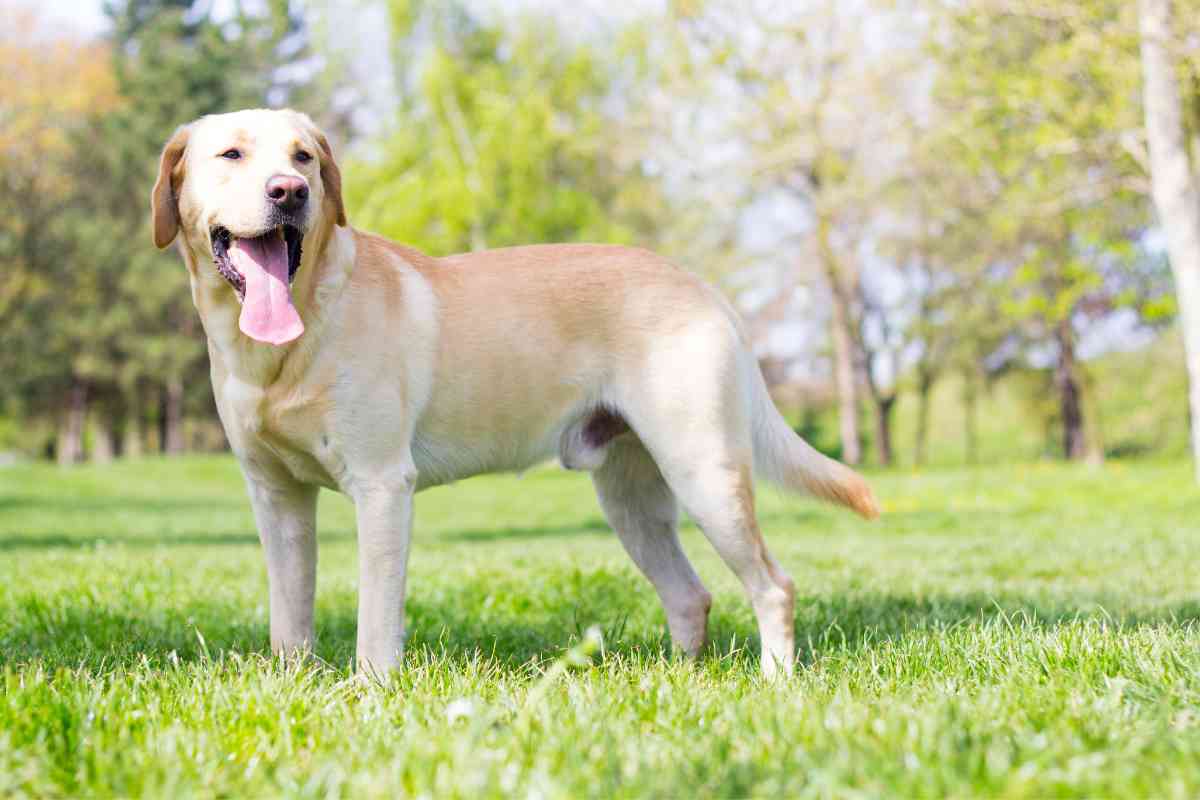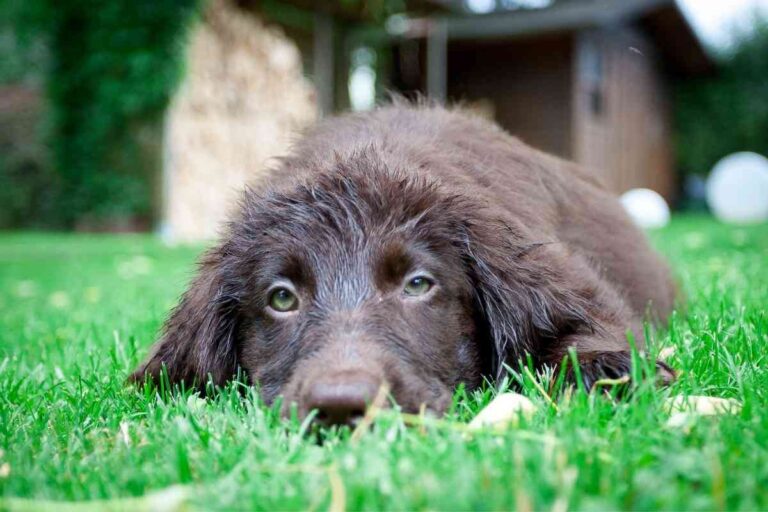Labrador Retriever Average Height: A Guide To All Ages
It’s good to know a Labrador dog’s average height before bringing a puppy home. Also, the implication of the lab’s height at different growth stages.

How tall are Labradors?
On average, Labradors’ height depends on their gender and age. Adult males are 22.5 to 24.5 inches tall, while adult females are 21.5 to 23.5 inches tall. This height, coupled with their average weight, makes labs a tremendous and sturdy dog breed for physical and mental stimulation.
The American Kennel Club grades or rates Labradors as a short-coated medium-sized dog breed. The females are known to grow to a height of 21.5 to 23.5 inches around the shoulders.
On the other hand, males can potentially grow to a size of 22.5 to 24.5 inches on the shoulders.
What is the Average Weight of Labradors?
Besides the average height, weight also matters. Healthy male adult labs average 65 to 80 pounds, while females weigh 55 to 70 lbs. This weight is maintained by a minimum of 40 minutes of exercise/walking daily.
Owners must know that labs are highly prone to obesity and hence need a lot of exercise to maintain their form.
Always check to ensure that the Lab has not overgrown or has excess fat deposits that you can feel their ribs on the coat. Failure to do so should necessitate a vet’s call to confirm that no dietary adjustments are needed.
Why Do Weight and Height Matter?

Labradors are some of the best dog breeds in the world. They are also popular and often chosen as family dogs because they are ever-friendly and easy to train.
Their nature makes them great picks for most people across the globe.
However, when raising a Labrador, it is vital to keep tabs on their growth milestones from when they are puppies to when they become seniors. This involves monitoring their weight and height through the different growth stages.
Note that these milestones provide essential information, especially regarding training and dietary choices.
Specific nutritional requirements come about due to the performance of the pups at particular stages of growth. It is, therefore, very significant to keep track of the changes.
Monitoring your Labrador can help you know when the growth is happening as it should. You can also respond accordingly if there seems to be rapid growth or if the development seems to happen slower than it should.
What are a Few Facts About the Labrador You Must Know?
A few traits that all healthy labs should portray include having a dense, short, and water-resistant coat. The dog should have a mid-sized muscular body. The average expected weights and heights should be within those specified above.
However, you should not panic if your lab falls below the measurements since they could still be healthy.
What is a Labrador Healthy Height Growth Chart?
We shall look at the different growth stages of the puppy’s life based on gender. Males and females have different growth rates; hence they will post different results during the tracking phase.
Generally, these are some figures you should expect to see for healthy and normal Labrador puppies.

The Male Growth Pattern
- 8 weeks – 8 to 12 inches, and 8 to 12 lbs
- 9 weeks – 8 to 12 inches, and 10 to 14 lbs
- 10 weeks – 10 to 12 inches, and 12 to 18 lbs
- 11 weeks – 10 to 12 inches, and 14 to 19 lbs
- 3 months – 12 to 15 inches, and 22 to 26 lbs
- 4 months – 12 to 15 inches, and 25 to 31 lbs
- 5 months – 15 to 18 inches, and 33 to 49 lbs
- 6 months – 15 to 18 inches, and 40 to 50 lbs
- 7 months – 16 to 19 inches, and 51 to 59 lbs
- 8 months – 18 to 20 lbs, and 55 to 60 lbs
- 9 months – 20 to 23 inches, and 57 to 68 lbs
- 10 months – 22 to 25 inches, and 55 to 58 lbs
- 11 months – 22 to 25 inches, and 62 to 75 lbs
- 12 months (1 Year Old Lab) – 22 to 25 inches, and 64 to 77 lbs
- 24 months (2 year old lab) – 22 to 25 inches, and 64 to 80 lbs
The Female Growth Pattern
- 8 weeks – 7 to 10 inches, and 8 to 12 lbs
- 9 weeks – 7 to 10 inches, and 10 to 13 lbs
- 10 weeks – 8 to 12 inches, and 12 to 17 lbs
- 11 weeks – 8 to 12 inches, and 14 to 19 lbs
- 3 months – 10 to 14 inches, and 20 to 26 lbs
- 4 months – 10 to 14 inches, and 25 to 30 lbs
- 5 months – 12 to 15 inches, and 35 to 49 lbs
- 6 months – 12 to 15 inches, and 38 to 50 lbs
- 7 months – 15 to 18 inches, and 40 to 55 lbs
- 8 months – 17 to 20 lbs, and 45 to 60 lbs
- 9 months – 20 to 22 inches, and 48 to 62 lbs
- 10 months – 21 to 23 inches, and 53 to 65 lbs
- 11 months – 21 to 23 inches, and 53 to 66 lbs
- 12 months – 21 to 23 inches, and 55 to 68 lbs
- 2 years – 21 to 23 inches, and 55 to 70 lbs
Growth Variations in Labrador Puppies
Most dog parents note that lab puppies grow perfectly well from birth to 8 weeks. It is after this stage that significant changes begin to show up. This is also the safe time to bring a new Labrador puppy home.
You will realize that a lot of growth happens between the 8-week mark and the 10 months mark. The growth changes can be considered drastic, so pet parents need to stay alert and keep checking for milestones.
Note that each growth stage/ milestone has specific requirements.
The Labrador puppies need to be exercised differently depending on their growth stage. The diet and general attention needs will also fluctuate depending on their growth stage. Below are some expectations you should have depending on Labrador’s growth stage.
8 week Growth Stage
Most Labrador pets will face many behavioral changes because this is the first time they are genuinely away from their mothers.
Since this is when most pet parents take their Labrador puppies from the breeder, it is expected that the puppy will behave in specific ways to adjust to the new environment.
They may appear fearful and timid because of the newness of the new home and the fact that they are not near their mothers and siblings.
This is a time when a lot of attention is needed. Make sure to feed the puppy three to four times a day, keeping the meals in small sizes.
At this stage, you should also follow up and ensure that the pup is fully vaccinated. Start with potty training and other basic commands, such as leash training. The puppy is likely to be more responsive when younger.

The Labrador Puppy at 12 Weeks
More vaccinations are needed when the pup gets to this age. Make sure to have them get a minimum of 2 boosters of the DAP vaccine and a single shot of the Bordetella-Parainfluenza as well as the Leptospirosis, Lyme, and Canine Influenza vaccines.
With this, it is safe to start socializing the puppy and ensuring they are comfortable around other dogs.
You can also make training a daily schedule/ routine when the puppy is 12 weeks old. This will create a sense of routine as the puppies begin to gain independence and start testing borders.
They may be a bit rebellious, but if you stick to a training routine, they will acknowledge and quickly fall back in line.
Also, watch out for Labrador biting behavior because it becomes more prevalent at this stage. The Labrador puppies will begin to chew on anything and everything they come across. Get them safe chew toys and use reinforcing commands to slowly guide them out of this habit which they may ditch when they turn 6 months old.
Labrador Puppies at 16 Weeks
This is a stage where the puppy must be fully vaccinated and receive the third DAP booster and get the first rabies shot at this age.
This is the perfect stage to house-train the puppies and ensure they get to acknowledge your authority.
Watch out for more biting and chewing incidences, as they will likely chew on items more aggressively.
Assert your authority and dominance as the master since the puppies get more independent at this stage and are likely to ignore your commands. Please ensure you are firm but soft, so they learn to recognize your authority without cowering.
Labrador Puppies at 6 months
This is a near-end development for the lab puppies. They tend to be more playful, making their real personalities more evident. You can reduce their feeding to two sizable meals daily and ensure they eat slowly.
They will most likely begin teething and soon start showing signs of adulthood, with the females getting their first heat at about 7 months.
The growth patterns continue when the puppy becomes an adult Labrador. Watch out for signs of rapid or stunted growth and respond accordingly.
The dog’s activities can also affect the dog’s growth habits. Consult your vet if you notice anything out of the ordinary.
Key Takeaways
- Labradors have varied weights and heights depending on their growth stages
- Male and female labs grow at different rates
- Monitoring the growth rate of your Labrador puppies is crucial for their health status.






